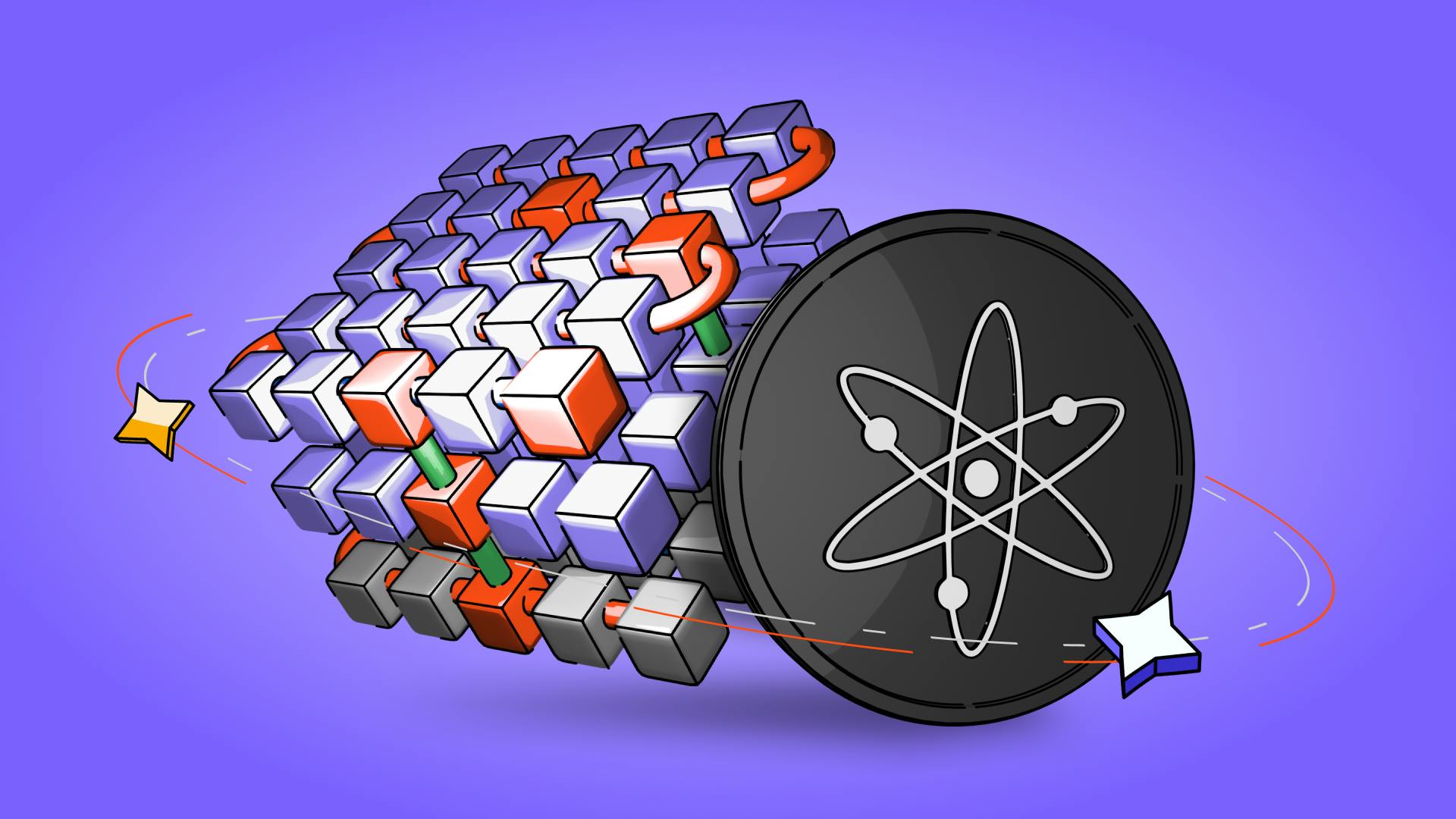Introduction to Cosmos (ATOM): The Internet of Blockchains
December 5, 2025

by Coinmetro Editorial Team
December 5, 2025
Cosmos is a decentralized network designed to connect multiple independent blockchains. Often referred to as the "Internet of Blockchains," Cosmos aims to solve one of the biggest problems in the blockchain space - the lack of communication between different chains. By enabling these networks to share data and work together, Cosmos makes the entire blockchain ecosystem more powerful.
Cosmos's main goal is to create an interconnected world where different blockchains can seamlessly transfer assets and information. This approach increases the functionality of each blockchain and boosts the potential for innovation across the space. As a result, Cosmos helps reduce blockchain isolation and drives the development of applications that can interact with multiple networks at once.
The benefits of this interconnectivity are significant. It allows users to access services and assets across different blockchains without intermediaries. It also addresses issues like scalability, as the network can handle more transactions by spreading the workload across multiple chains. In essence, Cosmos creates a more open and flexible environment for developers, businesses, and users to build and use blockchain technology effectively.
In this blog, you will learn about:
- What is Cosmos?
- The problem Cosmos aims to solve
- How Cosmos works: Understanding the technology
- The Cosmos Hub and ATOM token
- Real-world applications
- Cosmos vs. other interoperability solutions
Learn More About Blockchain Interoperability: Why It Matters & Key Solutions
As mentioned, Cosmos is a decentralized network of independent blockchains. It connects separate chains to enable communication and data sharing. This design addresses blockchain challenges like scalability and interoperability. The entire Cosmos ecosystem is comprised of:
- The Cosmos Hub anchors this ecosystem as its first blockchain. It links various networks together for smooth data and asset transfers.
- ATOM, the native token, secures the network through staking and drives governance decisions.
- Tendermint powers Cosmos as a secure, fast Byzantine Fault Tolerant consensus algorithm.
- Cosmos SDK modular framework lets developers build custom blockchains easily.
These tools create a scalable, flexible infrastructure. They distribute workload across chains, boosting efficiency. Cosmos fosters a connected blockchain ecosystem with enhanced functionality.
Blockchain faces some tough barriers like interoperability, scalability, and isolation. Most blockchains operate solo, restricting data and asset exchanges. This curbs their value and slows expansion, creating a siloed ecosystem.
Scalability challenges blockchain networks. More transactions often mean delays or higher fees. Isolated chains can slow innovations, hindering industry progress.
Cosmos solves these with clever design: Tendermint delivers secure, swift consensus. IBC connects blockchains, and the Cosmos SDK supports tailored chain builds.

Tendermint serves as the consensus engine that powers the Cosmos network. It uses a Byzantine Fault Tolerant (BFT) algorithm, which allows the network to reach agreement on transactions even if some nodes fail or act maliciously. This approach ensures fast transaction finality and maintains network security without requiring the energy-intensive processes used by proof-of-work blockchains. Tendermint’s design also supports high throughput, making it suitable for applications that require fast processing times.
The Inter-Blockchain Communication (IBC) protocol is the key to Cosmos’ vision of interconnected blockchains. It allows different blockchains to exchange data and assets in a secure and decentralized way. IBC enables these networks to work together as part of a larger system, making it easier for users to transfer tokens or information between blockchains. This protocol helps solve the problem of isolated networks, promoting a more integrated and versatile blockchain ecosystem.
The Cosmos SDK helps developers build custom blockchains with ease. It offers a modular system, letting them pick features like governance, staking, or token management. This approach balances flexibility with Cosmos’ interoperability strengths.
Developers use the SDK to craft unique functions quickly. They avoid starting from zero, saving time and effort. The framework keeps blockchain projects sharp and connected.
The Cosmos Hub acts as the central blockchain within the Cosmos ecosystem, connecting various independent blockchains and enabling them to interact. It is a bridge that facilitates the secure transfer of data and assets between these networks. This design ensures that users can seamlessly move assets across multiple blockchains without the need for centralized exchanges.
The native token of the Cosmos Hub, ATOM, plays a vital role in securing and governing the network. Staking ATOM allows users to participate in the network's consensus process by locking up their tokens as collateral, which helps secure the network and validate transactions. In return, stakers receive rewards in the form of additional ATOM tokens. This staking mechanism encourages active participation and ensures the network remains secure and reliable.
ATOM is also used for governance, allowing holders to influence decisions about the network's future. Users can vote on proposals related to software upgrades, parameter changes, or other important matters. This decentralized decision-making process ensures that the community drives the development of the Cosmos ecosystem. By staking and voting, ATOM holders play an essential role in shaping the network's growth and policies.
Several key projects tap Cosmos’ network for its interoperability and adaptable design:
Band Protocol - This data oracle uses Cosmos to feed accurate info across blockchains. The Cosmos SDK boosts its efficiency, while IBC ensures secure data flow. It supports DeFi apps needing real-time price updates.
Osmosis - A top decentralized exchange, Osmosis leverages Cosmos for flexible liquidity pools. IBC lets users trade assets across blockchains without centralized hubs. This setup enhances security and broadens liquidity and asset access.
Kava - A major DeFi platform, Kava offers lending, borrowing, and staking services. Built on the Cosmos SDK, it connects networks via IBC. Users can collateralize assets or earn yield seamlessly.
Cosmos also supports applications beyond DeFi. Gaming projects use it to link virtual economies with asset transfers. Akash Network, for example, uses Cosmos to provide decentralized cloud services, challenging traditional providers.
When comparing Cosmos to other blockchain interoperability solutions like Polkadot and Avalanche, some key differences in design and approach emerge. While all aim to connect different blockchains, they use distinct methods to achieve this goal.
Cosmos uses Tendermint for quick, secure consensus. Its fault-tolerant system keeps things stable despite potential node issues. IBC links blockchains, enabling easy data and asset swaps.
This setup lets chains stay independent yet connected. It perfectly suits projects seeking control and custom options. Cosmos ties them into a wider ecosystem.
In contrast, Polkadot uses a shared security model with a central chain known as the Relay Chain. In this setup, all connected blockchains, known as parachains, rely on the Relay Chain for security and consensus. While this model can offer strong security, it limits the autonomy of individual chains, as they must follow the Relay Chain's governance rules. Additionally, Polkadot has a limited number of parachain slots, which can create competition and high costs for projects wanting to join.
Avalanche, on the other hand, uses a three-chain architecture: the Exchange Chain (X-chain), Platform Chain (P-chain), and Contract Chain (C-chain). It enables interoperability through its Subnet model, where each subnet can have its own rules and consensus mechanisms. While this offers flexibility, creating custom subnets on Avalanche may require more technical expertise than using the Cosmos SDK and IBC.
Cosmos' use of IBC gives it a unique advantage by enabling modular interoperability, allowing blockchains to connect without relying on a central chain. This design improves flexibility and reduces potential bottlenecks in network performance. Projects prioritizing independence and customization may prefer Cosmos, as it allows them to develop specialized blockchains while benefiting from a connected ecosystem.
While Polkadot and Avalanche offer interoperability solutions with their strengths, Cosmos stands out with its decentralized approach and focus on flexible, modular connections. This makes Cosmos a strong choice for projects that seek greater autonomy and a wide range of use cases.
Cosmos is a decentralized network that connects independent blockchains, creating what is often called the "Internet of Blockchains." It solves major issues in the blockchain space, such as scalability and interoperability, by allowing different blockchains to exchange data and assets seamlessly. With its unique architecture—powered by Tendermint, the Cosmos SDK, and the IBC protocol—Cosmos helps blockchains work together without sacrificing their independence.
Cosmos is reshaping the blockchain industry by breaking down barriers between isolated networks. Its technology has enabled the growth of applications in DeFi, gaming, and decentralized cloud computing, making blockchain use cases more accessible and practical. Cosmos will likely play a central role in driving blockchain adoption as the ecosystem expands by fostering a more interconnected, flexible, and scalable infrastructure.
▶️ Watch: Is Cosmos (ATOM) Still Worth It? What You NEED To Know!
Join the Coinmetro community on Discord and Telegram, where forward-thinking traders and investors gather to share insights, explore new opportunities, and dive deep into cryptocurrencies. Should you need any help, please contact our world-class Customer Support Team via 24/7 live chat or email at hello@coinmetro.com.
To become a Coinmetro user today, Sign Up now or head to our new Exchange if you are already registered to experience our premium trading platform.
Tags
Related Articles

Regulatory Sandboxes: Fostering Crypto Innovation Within Legal Frameworks
The cryptocurrency industry’s fast rise fuels an important debate. Innovation aims to transform finance, enhancing speed and access. Yet, regulators…
5m

Crypto Options Trading: Strategies and Market Insights
Cryptocurrency markets have rapidly expanded beyond simple buying and selling. One of the most significant developments has been the rise of…
6m

The Rise of Social-Fi: Blending Social Media with Decentralized Finance
In recent years, social media and finance have started to merge, creating Social-Fi. This concept blends the engagement of social platforms with…
6m

DeFi Insurance Platforms to Watch in 2024
Decentralized Finance (DeFi) insurance addresses the growing need for insurance against hacks, smart contract failures, and other DeFi-related risks.…
7m